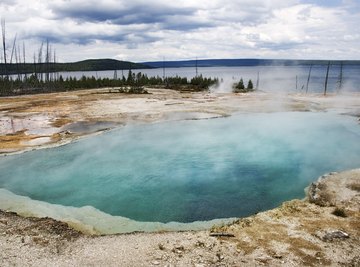
It might be nice to imagine that an anaerobic environment is a place where no one exercises. But no, that's not what it is!
TL;DR (Too Long; Didn't Read)
An anaerobic environment lacks oxygen.
Anaerobic means “without oxygen,” and it is the opposite of aerobic. So an environment with anaerobic conditions is just that – a place lacking oxygen that humans, giraffes, fish and much other life on Earth needs to survive.
These organisms use oxygen as an important molecule to accept electrons in cellular respiration, the series of chemical reactions by which food is converted to energy. In the absence of oxygen, cellular respiration uses alternative molecules, such as nitrate, sulfate, sulfur and fumarate. Or an organism might use an entirely different process of generating energy: fermentation. Fermentation, however, is far less efficient than cellular respiration.
Examples of anaerobic environments include soil and mud, the inner guts of certain animals and hydrothermal vents deep under the sea. These places are not, in fact, devoid of life. But the life that typically exists there is small, often single-celled and hardy.
Types of anaerobic bacteria
Some bacteria are versatile; they can use oxygen to make energy when it is available, but they can switch to another method of cellular respiration under anaerobic conditions. These are called facultative bacteria. For some of these bacteria, growth slows down significantly when the environment dictates that they must switch to rely on less-efficient anaerobic cellular respiration.
In contrast, obliquely anaerobic bacteria cannot survive if oxygen is around at all. Obligate anaerobes are commonly found in the human body, including in the mouth and GI tract, and they can cause disease or infection. For example, Porphyromonas can lead to a type of pneumonia or periodontitis (a gum inflammation). Meanwhile the Clostridium species, under strictly anaerobic conditions, can cause gangrene (an infection of muscle tissues associated with open wounds).
Other anaerobic bacteria range somewhere in between – they can tolerate some oxygen, but only at certain concentrations. Sometimes called aerotolerant bacteria, these bacteria do no immediately die in the presence of oxygen, but nor can they use it in cellular respiration. Instead they use fermentation to generate energy.
Tardigrades
Not all life in anaerobic conditions is a bacterium. The tardigrade, also known as a water bear, is one millimeter-sized organism that can withstand not only a lack of oxygen, but also a lack of water, extreme temperatures (hundreds of degrees above or below zero), being immersed in boiling alcohol, radiation exposure and even a vacation in space. Part of how it can do these feats is by temporarily shutting down its vital functions to rest in a state of suspended animation, similarly to how other animals may hibernate for the winter. The tardigrade, however, can stay this way for decades until conditions become more favorable.
Anaerobic Composting
Anaerobic bacteria are often found in soils and can be particularly helpful for anaerobic composting – where food scraps and other organic materials are left in a sealed environment to break down into nutrient-rich fertilizer. Someone looking to avoid the putrid smells of fresh compost in their yard might use this method of letting anaerobic bacteria break down their food waste. Anaerobic composting creates a highly acidic environment much like a human stomach inside whatever bin or bag is holding the compost.
Anaerobic Nitrification
Another important job that takes place by specialized bacteria in anaerobic environments is nitrification. This is the process by which nitrogen gas is incorporated into solid matter. Because plants need to access nitrogen from their roots in order to grow, anaerobic bacteria in soil perform an important role in making effective fertilizers and allowing nitrogen to circulate throughout the environment.
References
About the Author
Amy Dusto is a high school science teacher and a freelance writer. She holds a Bachelor of Arts in Natural Sciences area and a Master of Arts in Science Writing from Johns Hopkins University. She has contributed to Discovery.com, Climate.gov, Science News and Symmetry Magazine, among other outlets.
Photo Credits
Jupiterimages/Comstock/Getty Images
